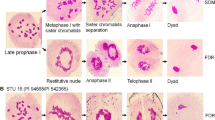Summary
Nuclear behavior during ascosporogenesis ofSordaria sclerogenia Fields and Grear was studied with the use of the HCl-Giemsa staining technique. Except for some spore abortion and occasional irregular mitotic divisions in the spore, the chromosome behavior was found to be compatible with that reported for other members of theSordariaceae and other pyrenomycetes with eight linearly arranged ascospores. A haploid chromosome complement of seven was found. The behavior of the centriolar-bodies during meiosis in this organism is discussed.
Similar content being viewed by others
References
Fields, W. G., andJ. W. Grear, Jr., 1966: A new heterothallic species ofSordaria from Ceylon. Mycologia58, 524–528.
Lu, B. C., 1967: The course of meiosis and centriole behavior during the ascus development of the ascomyceteGelasinospora calospora. Chromosoma22, 210–226.
Author information
Authors and Affiliations
Additional information
Supported by the US National Science Foundation, Grant GB-7392, and“FundaÇÃo de Amparo à Pesquisa”, SÃo Paulo, Brasil, Grant 68/578.
Rights and permissions
About this article
Cite this article
Furtado, J.S. Ascal cytology ofSordaria sclerogenia . Protoplasma 67, 473–478 (1969). https://doi.org/10.1007/BF01254908
Received:
Issue Date:
DOI: https://doi.org/10.1007/BF01254908




